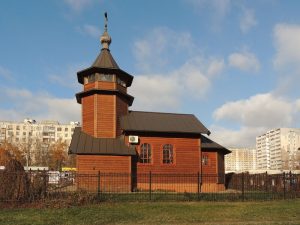Temple-Chapel «Assuage my sorrows» of the Icon of the Mother of God in Medvedkovo

The Chapel of the Icon of the Mother of God “Quench My Sorrows”, attached to the Church of the Intercession of the Most Holy Mother of God in Medvedkovo, is located near the Metro station “Medvedkovo” (14, Shirokaya Street). In the central part there is a beautiful four-tiered iconostasis, reminiscent of the ancient tablas structures used in the churches of the Russian North. In the same style the covers of two large icons are made – the icon of the Saviour and the temple icon of the Mother of God “Quench My Sorrows”, especially venerated by the parishioners. The village of Medvedkovo was first mentioned in the Book of Scribes in 1623 as the property of Prince D.M. Pozharsky. After the liberation of Moscow D.M. Pozharsky made Medvedkovo his residence. In 1623 a wooden church was built in the village in honour of the intercession of the Holy Virgin Mary with a bell to commemorate the liberation of Moscow. The church had a side chapel in honour of St. Peter of Alexandria, the patron saint of D.M. Pozharsky’s son. In 1634-1635. Pozharsky built a stone temple in place of the old wooden one, also in honour of the intercession of the Blessed Virgin Mary. The temple became one of the last single-chapel temples in Moscow, the construction of which was later forbidden by Patriarch Nikon. In 1635 the number of side chapels was increased to five. Medvedkovo passed to Prince V.V. Golitsyn (1633-17). Golitsyn (1633-1713), a favourite of Tsarevna Sophia. When Sophia lost power, Golitsyn was exiled to Pustozersky ostrog in 1689. Golitsyn managed to do a lot during his short possession of Medvedkov: he rebuilt the aisles of the church, leaving three (the Church of the Protection, the Sign and the Nine Martyrs of Kizik), and added the aisle of Sergius of Radonezh in 1690. He also ordered a new iconostasis and replaced the bells associated with Pozharsky with new ones cast by Dmitry Motorin. According to the legend, Tsarevna Sophia presented the Medvedkovo Gospel to the church. In 1787-1795 the temple was covered with iron, and the metre of 1827 describes significant changes in its appearance. Medvedkovo became popular with the inhabitants of Moscow dachas. Here lived the artist K.A. Korovin, who was often visited by M.A. Vrubel. The poet V.Y. Brusov also visited these places. In the XIX century the temple underwent changes: the iconostasis was rebuilt, new icons were added, a new bell tower in the classical style was built, the royal gates of the XVII century were lost. Since its construction the temple has never been closed, only in the 1920-40s of the twentieth century services were held in the lower church. In the archives there is a passport of the church from 1931. After the Great Patriotic War, when the church was repaired, services were resumed in the upper church. At that time Archimandrite Sergius (Saveliev) was appointed rector. He began his spiritual activity in the mid-1920s, inspired by the legacy of the monk Seraphim of Sarov. Under Sergius the icon of the Protection of the Holy Mother of God was painted, probably by the nun Juliana Sokolova. It is placed in a ciot to the right of the central iconostasis. At the same time the Shroud of the Dormition of the Virgin Mary was made, which is located in the western gallery above the main entrance to the temple. Under Archimandrite Sergius the clergyman Fr. Porfiry Dyachek, later appointed rector, was sent to the Church of the Protection of the Holy Mother of God. Under Father Porfiry the Sunday school for children was founded, the temple was restored and the construction of the priests’ house began. Archpriest Porfiry served in the Church of the Intercession for about a quarter of a century, in 2002 he was transferred to the Church of the Life-Giving Trinity in the Pyatnitsky cemetery. Since 2002 the rector of the temple is Fr. Valentin Timakov.
Address: Moscow, Shirokaya str., 14

